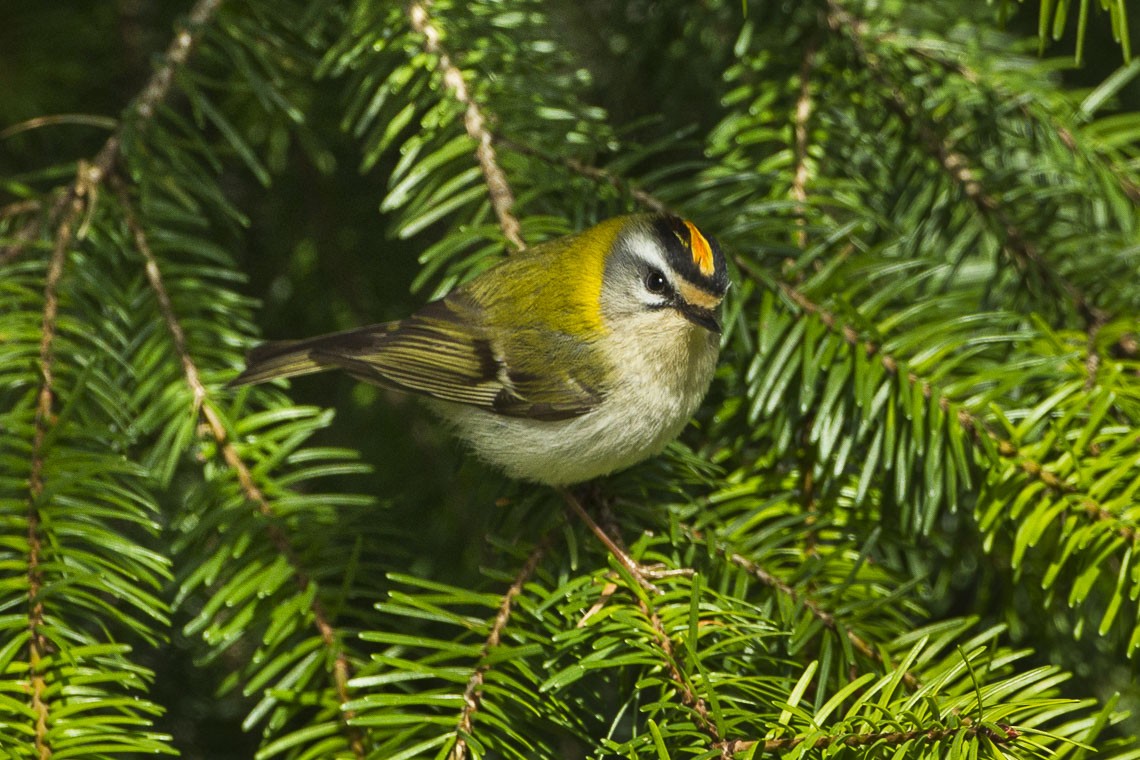Common Firecrest
A species of Kinglets Scientific name : Regulus ignicapilla Genus : Kinglets
Common Firecrest, A species of Kinglets
Botanical name: Regulus ignicapilla
Genus: Kinglets
Content
Description People often ask General Info
 Photo By Francesco Veronesi , used under CC-BY-SA-2.0 /Cropped and compressed from original
Photo By Francesco Veronesi , used under CC-BY-SA-2.0 /Cropped and compressed from original Description
The common firecrest is a small plump bird, 9 cm (3.5 in) in length with a wingspan of 13–16 cm (5.1–6.3 in), and weighs 4–7 grams (0.14–0.25 oz). It has bright olive-green upperparts with a bronze-coloured patch on each shoulder, and whitish underparts washed with brownish-grey on the breast and flanks. It has two white wingbars, a tiny black pointed bill, and brownish-black legs. The head pattern is striking, with a black eye stripe, long white supercilium, and a crest which is bright yellow in the female and mainly orange in the male. The sexes are very similar, apart from the crest colour, although the female is a little duller in plumage and on average slightly smaller. Juveniles have a grey tinge to the duller upperparts, and lack the coloured crown; the other head markings are present, but duller than in the adult. By their first winter, only the flight and tail feathers remain unmoulted, and the young birds are virtually indistinguishable from the adults in the field. This kinglet usually hops with its body held horizontally, and its flight is weak and whirring, with occasional quick evasive turns. Adult firecrests are unlikely to be confused with any other species; Pallas's warbler has a similar head and wing pattern, but its crown stripe is pale lemon, not bright yellow or orange, and its supercilium is also pale yellow, not bright white. The juvenile common firecrest might be confused with the goldcrest, but usually shows enough face pattern to distinguish it from its relative, which has a very plain face at all ages. The firecrest can also be separated from Pallas's warbler by the warbler's pale crown stripe and yellow rump. There is more likelihood of confusing the juvenile firecrest with the yellow-browed warbler, which has a similar head pattern; the warbler (an Asiatic species) has pale fringes to the feathers of the closed wing, a whitish belly and darker brown legs. The yellow-browed warbler also lacks the pale half circle present below the young firecrest's eye. 
Size
9 cm
Colors
Green
Yellow
Gray
Orange
Life Expectancy
4 years
Nest Placement
Tree
Feeding Habits
Common Firecrest predominantly feeds on small arthropods such as springtails, aphids, and spiders, including cocoons, eggs, and occasionally pollen. Common Firecrest hovers to snag flying insects, prefers larger prey, and beats them against branches to kill them. Common Firecrest forages in tree canopies, differing from goldcrests in prey size and foraging location. Adaptations include broader bills and smoother foot soles, aiding in capturing and perching. Nestlings eat mainly springtails, increasing food size with age. In winter, common Firecrest may join mixed-species flocks, enhancing foraging success and variability, and can visit bird tables for fatty foods.
Habitat
Common Firecrest thrives in lowland broadleaf and mixed forests across Europe, characterized by tree species like cork oak, alder, beech, and various conifers. Preferring regions with mild July temperatures ranging from 16 to 24 °C, its habitat extends to Mediterranean woodlands and North African Atlantic cedar forests, at elevations up to 2,800 meters. Urban green spaces also provide suitable environments, supporting its presence in parks and gardens.
Dite type
Insectivorous
People often ask
General Info
Feeding Habits
Bird food type
Sounds
Call
Recording location: Belgium
Song
Recording location: Belgium
Song
Recording location: Portugal
Distribution Area
The common firecrest breeds in lowland broadleaf forest, preferring cork oak and alder where available, otherwise beech and holly. It also uses mixed broadleaf and conifer woodland, and stands of spruce, European silver fir, cedar and pines, often with undergrowth of juniper, ivy and wild rose. In drier Mediterranean habitats it is found in conifers, evergreen oak, and mixed woodlands up to 2,800 m (9,200 ft). Unlike more specialised birds such as Eurasian nuthatch and common treecreeper, both of which forage on trunks, the crests do not need large woodlands, and their population density is independent of forest size. In winter it is less reliant on conifers than the goldcrest, moving from forest to fringes and scrub. It occurs singly or in pairs, spending much time in the tree canopy, although frequently venturing into bushes and other lower vegetation. This species can thrive in fairly urban areas, provided that suitable habitat is available in parks or large gardens; population densities in gardens can be comparable with the maximum levels found in natural habitats. The nominate subspecies breeds in Europe from southern England, France, Spain and Portugal east to Belarus, northwestern Ukraine, and Greece, and north to the Baltic and southern Latvia. There are isolated populations east of the main range in Abkhazia, the Crimea and Turkey. Its range lies between the 16 and 24 °C (61 and 75 °F) July isotherms. Southern birds are largely resident, unlike northern and eastern populations which are migratory, wintering mainly in Mediterranean areas and the far west of Europe from Portugal north to Britain. R. i. balearicus is resident in the Balearic Islands and the northern parts of Morocco, Algeria and Tunisia. This species has been recorded as a vagrant from Norway, Finland, Estonia, Cyprus, Egypt and Lebanon. In July 2020, it was reported that the common firecrest was now nesting in at least two locations in southern Finland. 
Species Status
Not globally threatened.
Scientific Classification
Phylum
Chordates Class
Birds Order
Perching birds Family
Goldcrests and kinglets Genus
Kinglets Species
Common Firecrest